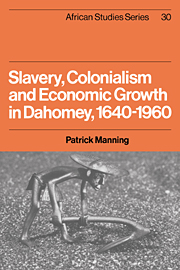Book contents
- Frontmatter
- Contents
- Maps
- Tables
- Figures
- Preface
- 1 Slavery, colonialism and economic growth, 1640–1960
- 2 The Dahomean economy, 1640–1890
- 3 Struggles with the gods: economic life in the 1880s
- 4 Production, 1890–1914
- 5 Demand, 1890–1914
- 6 Exchange, 1890–1914
- 7 The alien state, 1890–1914
- 8 Social struggles for economic ends, 1890–1914
- 9 The mechanism of accumulation
- 10 Capitalism and colonialism, 1915–60
- 11 The Dahomean national movement
- 12 Epilogue
- Notes
- Appendix 1 Export revenue from Dahomey, 1640s–1950s
- Appendix 2 Slave exports by ethnic origin
- Appendix 3 Population loss due to slave exports
- Appendix 4 Foreign trade of Dahomey
- Appendix 5 Foreign trade indices
- Appendix 6 Rainfall
- Appendix 7 Fiscal flows
- Appendix 8 Money supply of colonial Dahomey
- Bibliography
- Index
11 - The Dahomean national movement
Published online by Cambridge University Press: 26 October 2009
- Frontmatter
- Contents
- Maps
- Tables
- Figures
- Preface
- 1 Slavery, colonialism and economic growth, 1640–1960
- 2 The Dahomean economy, 1640–1890
- 3 Struggles with the gods: economic life in the 1880s
- 4 Production, 1890–1914
- 5 Demand, 1890–1914
- 6 Exchange, 1890–1914
- 7 The alien state, 1890–1914
- 8 Social struggles for economic ends, 1890–1914
- 9 The mechanism of accumulation
- 10 Capitalism and colonialism, 1915–60
- 11 The Dahomean national movement
- 12 Epilogue
- Notes
- Appendix 1 Export revenue from Dahomey, 1640s–1950s
- Appendix 2 Slave exports by ethnic origin
- Appendix 3 Population loss due to slave exports
- Appendix 4 Foreign trade of Dahomey
- Appendix 5 Foreign trade indices
- Appendix 6 Rainfall
- Appendix 7 Fiscal flows
- Appendix 8 Money supply of colonial Dahomey
- Bibliography
- Index
Summary
The opposition of the Dahomean bourgeoisie to the state's extractive and contractive economic policy engendered the major conflict of the colonial era. This polarization–in which the issue was how rather than whether Dahomey would enter the capitalist world–structured the full range of political conflicts induced by Dahomey's economic transformation. The movement was reformist rather than revolutionary, and it never challenged the right of France to rule Dahomey. Nevertheless it was an authentic, powerful–and, from the state's viewpoint, fearsome–movement seeking to bring economic and political benefits to the entire territory of Dahomey, though particularly to its merchant and planter leaders. From the time of World War I, the national movement maintained constant pressure on the state, and successfully tied virtually all of southern Dahomey into a single political system, extending its influence on a more limited basis into the North. It included among its allies some European entrepreneurs willing to join in the critique of the state, as they stood to benefit from the economic policy of the national movement. Even high state officials surreptitiously provided information and support to those who combatted official colonial policy. The national movement also relied significantly on support and developments in the wider world, particularly on Pan-African, revolutionary and anti-colonial movements centered in Paris. It was defeated and dismantled, however, under the pressure of the state's counterattack and as a result of the effects of World War II. Independence, by the time it was granted in 1960, came on terms closer to those of the colonial state than to those proposed earlier by the bourgeoisie.
- Type
- Chapter
- Information
- Slavery, Colonialism and Economic Growth in Dahomey, 1640–1960 , pp. 261 - 280Publisher: Cambridge University PressPrint publication year: 1982

